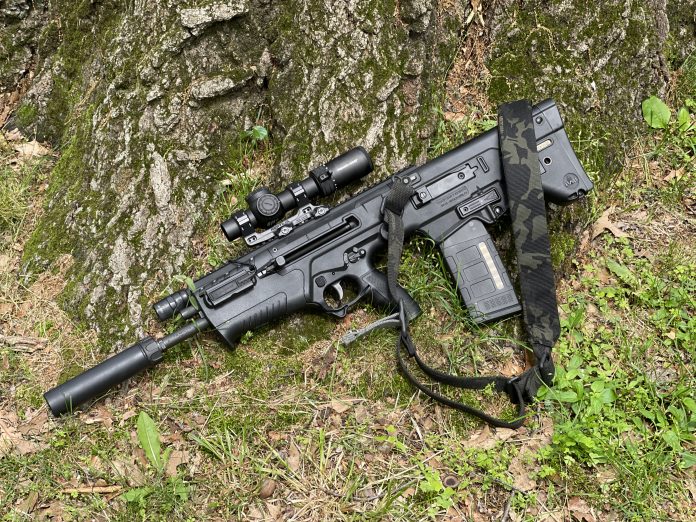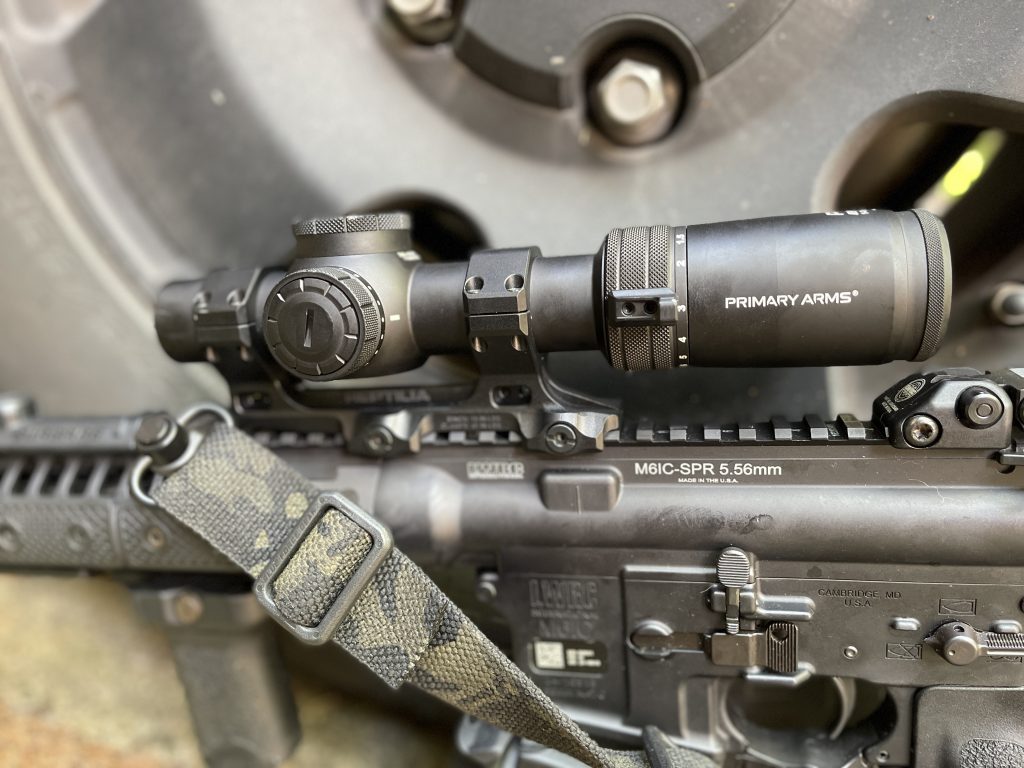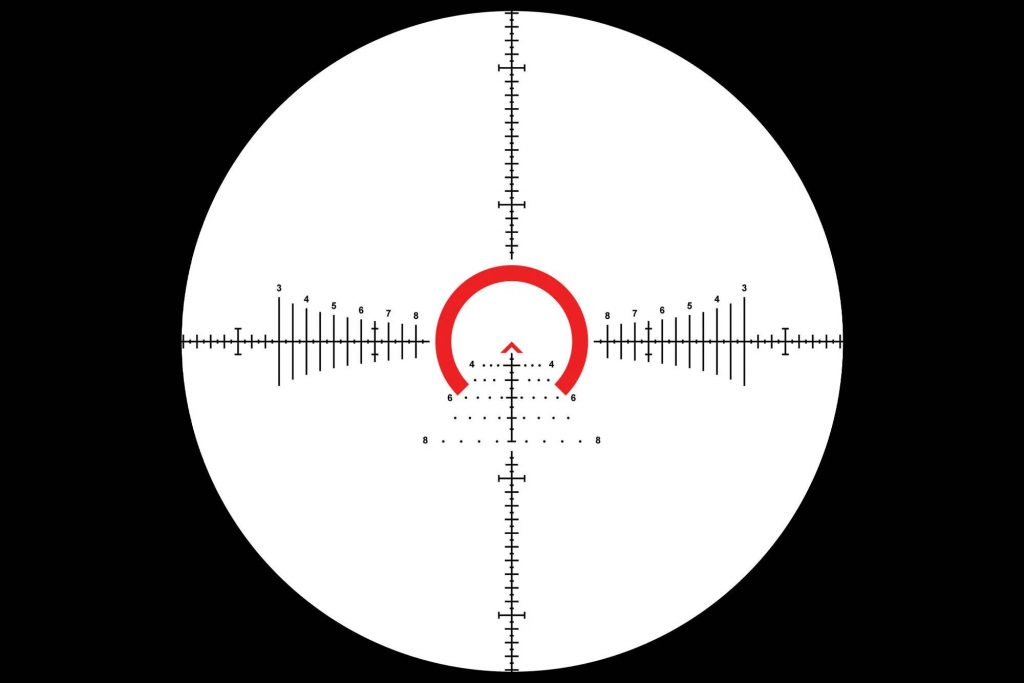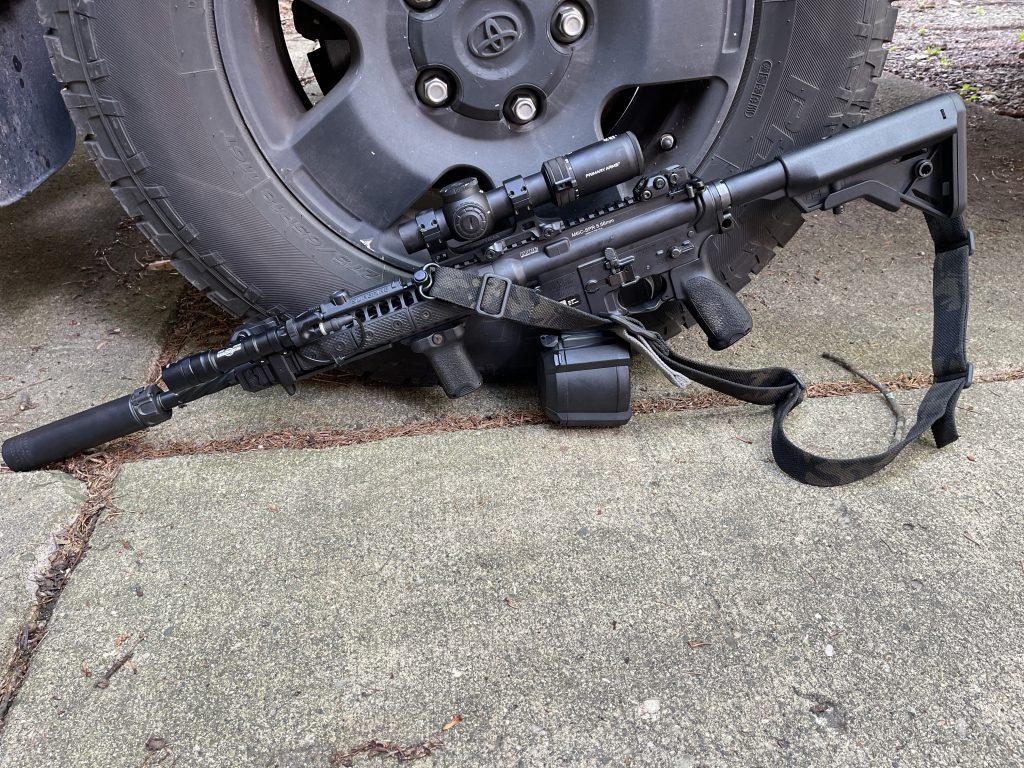
Three things are trending in LPVO development right now, smaller, lighter, and lower cost for quality. The PLXc is no exception. In fact it nicely illustrates the developmental momentum on nearly all fronts.
The Primary Arms Compact PLx, or PLX-C or PLXc, or however you’d like to place the letters, I like PLXc, so we shall proceed with that title. The PLXc is able to demonstrate a strong combination of current tech and lessons learned in the modern LPVO options suite.
The PA PLXc

Unless you’re Trijicon selling to the Marine Corps, which makes sense, Marines are Marines, most other scope makers are engineering to match or exceed the feature sets we’ve had in optics past, but in increasingly less weighty scope bodies. Manufacturers have been increasingly able to improve on other quality aspects over previous iterations and not merely miniaturize. Glass is better, controls are smoother or better designed, and costs are down.
Truth be told, there is really only one thing “new” in the new scope, its size. It’s housing is more typical of what we’ve come to see from 1-4x and 1-6x scopes, but this is a 1-8 FFP in a highly quality well glassed 30mm tube, 24mm objective lens.
Unsurprisingly, the PLXc is offered with the Primary Arms ACSS reticle system. The ringed chevron with range and wind assist markings is cleanly done and doesn’t commit the cardinal sin many FFP reticles do, too thick and too busy. It’s just enough at 1x to snap on quick, assisted by the wide and crisp FOV, and it gives the shooter information without being in the way at higher magnification settings. Exactly what you want out of an LPVO FFP reticle.
It does all this at less than 10 inches long (9.28in) and less than 17oz. For comparison, the Trijicon SCO is 32oz. For a more direct comparison, if I run an Aimpoint CompM5s and magnifier (3x-c model to 6x only have 1 oz difference) on Scaralworks LEAP mounts I’m at about 23oz. I put the PLXc in a Scalarworks 30mm LEAP scope mount and I am at the exact same optical weight, with 8x top magnification, everything in between down to a clear and wide FOV 1x, and far more information I can draw from the reticle than a dot.
No, still not your red dot replacement
If you are seeking an RDS type solution with magnification, the PLXc is not it. That super bright aiming point is still something most FFP optics struggle with, it isn’t their place. Look at Second Focal Plane options and RDS+Magnifier combinations, they are both still excellent options.
Now, if you want/need the always scaled, cleanly reticled, precise, and quick front focal plane option for a balance of accuracy, distance capability, and rapid shot placement capability, the PLXc does these exceptionally well.
It boasts an admirable field of view, 121ft at 1x, for comparison the USMC SCO (VCOG, 1-8x) has 109.2ft. at 1x in its absolute unit of a housing.
Consider where your rifle is living, not its full range of capabilities, when considering an optic.
In many instances, military application for example, an FFP optic with ballistic reticle matching the ammunition (or a quick reference of holds for the milliradian or MOA grids) will help the troop increase their hit probability substantially. Their rifles routinely live out to 300 or 500 yards, with an optic like the PLXc everything within 600 yards is pretty well within reach on almost every conceivable rifle or carbine. An M16A4, MK12 SPR, or .308 16-20″ types could reach 800 yards without much difficulty and a proper round.
Adhering to the 1x per 100 yards rule, the PLXc is a strong GPR optical contender.
In contrast, if you are living within the 50 yard world and are setting the rifle up to be most efficient there, but with the ability to push range and observation, the PLXc can certainly do the job but might not be the best LPVO or optical choice. You are likely prioritizing the fastest sight picture you can achieve, and that gets easier with a bright center reticle.
Dots remain speedy sight picture kings with the ability to superimpose the bright red (or green) dot over center mass and manipulate the trigger.
The PLXc is still limited on the brightness, most FFP optics are. They have very little reticle to contrast against in the etched glass. However it is etched glass, and therefore a solid state reticle, and the contrast illumination on it is very good for etched glass. In the bright conditions where the illumination is starting to fade you don’t need it illuminated, and in dark conditions it has solid contrast. You can hit the dark target with white light.
If you want this optic and its admirable capability set, you can certainly make it do the work without too much grief. If you need to chase the shiny red dot like a cat, SFP for you.
Precision within the range envelope
Making precise shots within a given range, even a distance some would consider ‘close’ starting at about 50 yards, say in the 70-77 yards arena where the average police sniper shot distance is hovering, then the ACSS M8 reticle could be exceptionally useful to you.

The chevron reticle type will forever remain one of my favorites for placing a precise shot. Dots are well and good for covering a point of aim and squeezing a quick shot off, but anyone who has tried to shoot with a dot and it ended up obscuring a large portion of the target after a certain distance can appreciate the fine aiming point that a chevron gives. The chevron is still easy to use as an occlude and shoot solution too, just like an RDS, as it is about 1 MOA thick, 3 MOA tall total, and about 6 MOA leg to leg.
I knew the actual dimensions, or saw them at some point, but I couldn’t find them while writing this. The short version is put the chevron on the target and squeeze the trigger if the chevron fits inside the target. Even a 6″ steel circle target should fit to 100 yards and a to-scale silhouette type to 300 yards.
The chevron also benefits from the fact it’s always to scale, illuminated or not. An overly bright dot can obscure a small target even when the dots projection size is small, 2 MOA being an industry standard, the occlusion may be effectively much larger than that. You can adjust, of course, but it’s consistency is one of the additional factors I live about the sight picture of a solid state reticle. The first factor being that the reticle is very clear and crisp with my astigmatic eyeballs
Offsetting factors
For trajectory estimates, starting close, the round will rise up to the bottom of the horseshoe of the reticle at about 10 yards, be between the legs on the chevron at around 40 yards, and be within the filled chevron body from about 60 yards until 200 yards, with 100 yards being the chevron tip itself. This is a rough assumption off an M193 type 55gr load, at above 3k fps muzzle velocity, and a 100 yard zero. Other rounds and zeros will change the trajectory, but doping good holds and doing the math on any load you want shouldn’t be hard to write up.
The 0-300’s on most rounds are going to be similar enough to make the BDC usable, you’ll notice increasing difference beyond that as velocity and BCs vary. The most notable change would be in using .300BLK or 7.62×39, as they have significantly lower muzzle velocities. Using an SBR will also steepen your fall off.
If you’re setting the rifle up for serious precision intent, map it out with your ammunition for more exact holds at distance. Don’t rely on an app, get real data.
Not a VCOG, doesn’t need to be.

I’ve compared the PLXc to the VCOG SCO at a few points now because the VCOG represents a similar performance envelope with a vastly different constructive intent. The VCOG is built for extreme end durability, like the ACOG and Aimpoint CompM series are, weight savings are not a critical element if it compromises the optic durability parameters.
The PLXc occupies the tier below this extreme end. IPX7 is usually the emersion rating along with typical high rate recoil/shock hardening. Optics like the Razor II, Razor III, NX8, VUDU, and Tango6T all occupy this ‘durable’ category with the PLXc, and several of those have been adopted into military use.
Shorter underwater time limits and depths for the stand out differences from the VCOG. You could dive with a VCOG to 20 meters. With any of the other listed scopes you could safely cross a river with the water at chin height and the rifle under water but you’ll want to get out of the water in a timely fashion, IPX7 lists 30 minutes at 1 meter depth/pressure. The optic will not care about rain. The VCOG will have a higher absolute limit for crush damage and impact damage thanks to the tougher (and harder to machine) aluminum, but neither it or the optics in the tier beneath are going to care much if the rifle tips over, gets tripped and fallen on, or falls off a truck tailgate.
Let’s be real, we live in a fall in the mud, rifle falls off tailgate, trip and knock the gun around world. Not so much the swim out of a torpedo tube 20 meters down, infiltrating unspecified beach. We can appreciate the PLXc, Razor, NX8 type durability fully, the VCOG is a tad overbuilt and mission specific beyond our reality.
It doesn’t hurt that you can get two PLXc’s for the cost of a VCOG, it is more logistically friendly in that regard. If I am mapping a budget for say department patrol rifles in a northern (or southern) rural area with longer shots, potentially dangerous wildlife, and substellar weather I might have my rifle out in for several hours, the PLXc would fill that bill nicely.
Through the looking glass
The PLXc excels with that expansive field of view. Most LPVOs give you a notable tube effect looking through them at 1x, the PLXc has a very clean eyebox that has minimized this, once your diopter is set properly for your eye. I think the 30mm tube and the glass selection lend to this exceptionally nice disappearing act the scope body performs during use. I don’t know if the PLXc has the best FOV in the 1-8 sphere, but it beats the VCOG, NX8, ATACR, and S&B PM II Short Dot by various degrees.
At maximum magnification the eyebox narrows down, per usual, but is still clearly defined, you either have a clean and useable sight picture or you can’t see through the scope.
The reticle is useable through the entire magnification range, something that should be an obvious design intent but was often overlooked to focus on 1x, 8x, or both without much consideration to the middle. The PLXc suffers no such limitation.
Illumination, as noted above, remains the hardest limit on this scope. In a bright environment the chevron and horseshoe can contrast but they won’t shine. The contrast is excellent on the high settings in bright environments, it doesn’t get easily overwhelmed, but I wouldn’t call it daylight bright. Many early options, even from premium manufacturers, suffer from illumination overwhelm or the reticle bleed into the sight picture on high settings.
The PLXc suffers none of these, optical progress.
Click, click, boom
The Nightforce NX8 is likely the most comparable optic, as it is sitting in the same size, weight, and focal plane range. Even not too far off in price, being only $250 above the PLXc.
I would take either with no other options, but I prefer the PLXc for two reasons. The .1 MRAD adjustments on the PLXc compared to .2 MRAD on the NX8, I think FFP optics at 8x and 10x benefit from the finer adjustment, and the field of view.
While the NX8 is undeniably a finely built optic and there would be little reason to replace it if owned already, if I were picking a scope between the two I’d be most likely to pick the PLXc. It would arguably be a difficult choice against the ATACR now too.
Comparisons
I’ve done more comparing and contrasting in this review than I typically do for a firearm review. That is for two reasons.
First, the optic is going to provide additional function to a firearm where a firearm can stand alone.
Second, the field of LPVO optics is neatly stacked with excellent options so finding where this one fits into that is more a comparative search than saying if this optic is standalone reliable. Optics don’t stand alone.
The overlap between optic types in similar magnification ranges also causes some confusion on where an optic is designed to perform strongest. Like an M4A1 clone(ish) and a Mk12 are both AR-15’s, not dissimilar in size, but are built for very different jobs. Optics are the same way, even if they both say 1-8x.
Conclusion
The PLXc is benefitting from a solid decade of rapid LPVO development in the competitive commercial space. Primary Arms listened to the lessons learned by it and other optics companies as the mass market(s) figured out there requests.
The Leupold 1.1-8 CQBSS was one of the earliest examples and the PLXc is among the latest. The PLXc is shorter, lighter, with a better field of view, and 2.5 times less expensive than the Leupold, current day, for the same performance envelope. That’s a decade of development at work.
The PLXc is an excellent iteration in LPVO tech, possess a feature set worth considering, and at a very competitive price point for the category.
For someone looking for an optic to exploit full service rifle/carbine effective ranges or push into the DMR category, it should be on the consideration list. It could save you space, weight, and a bit of money while giving up nothing.



